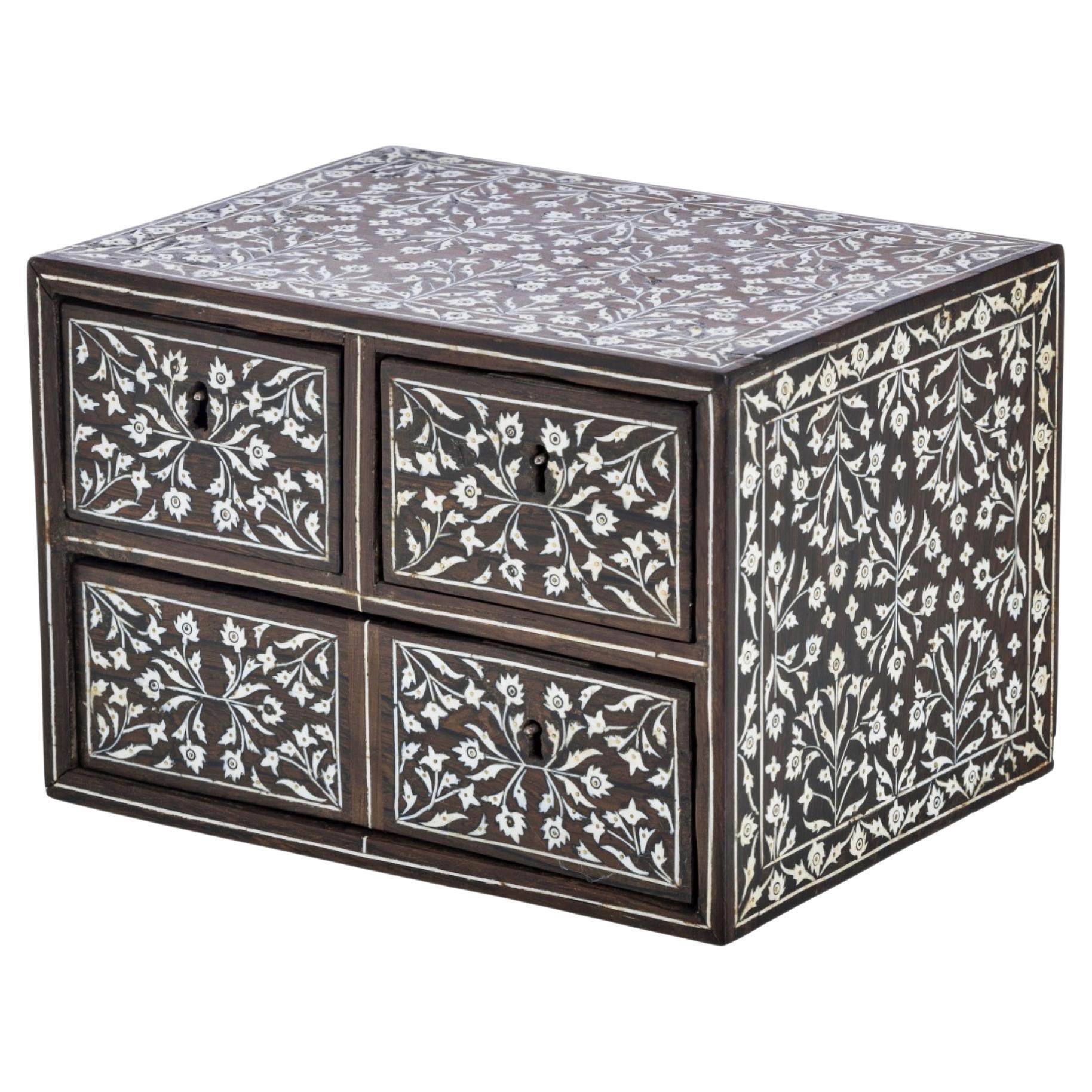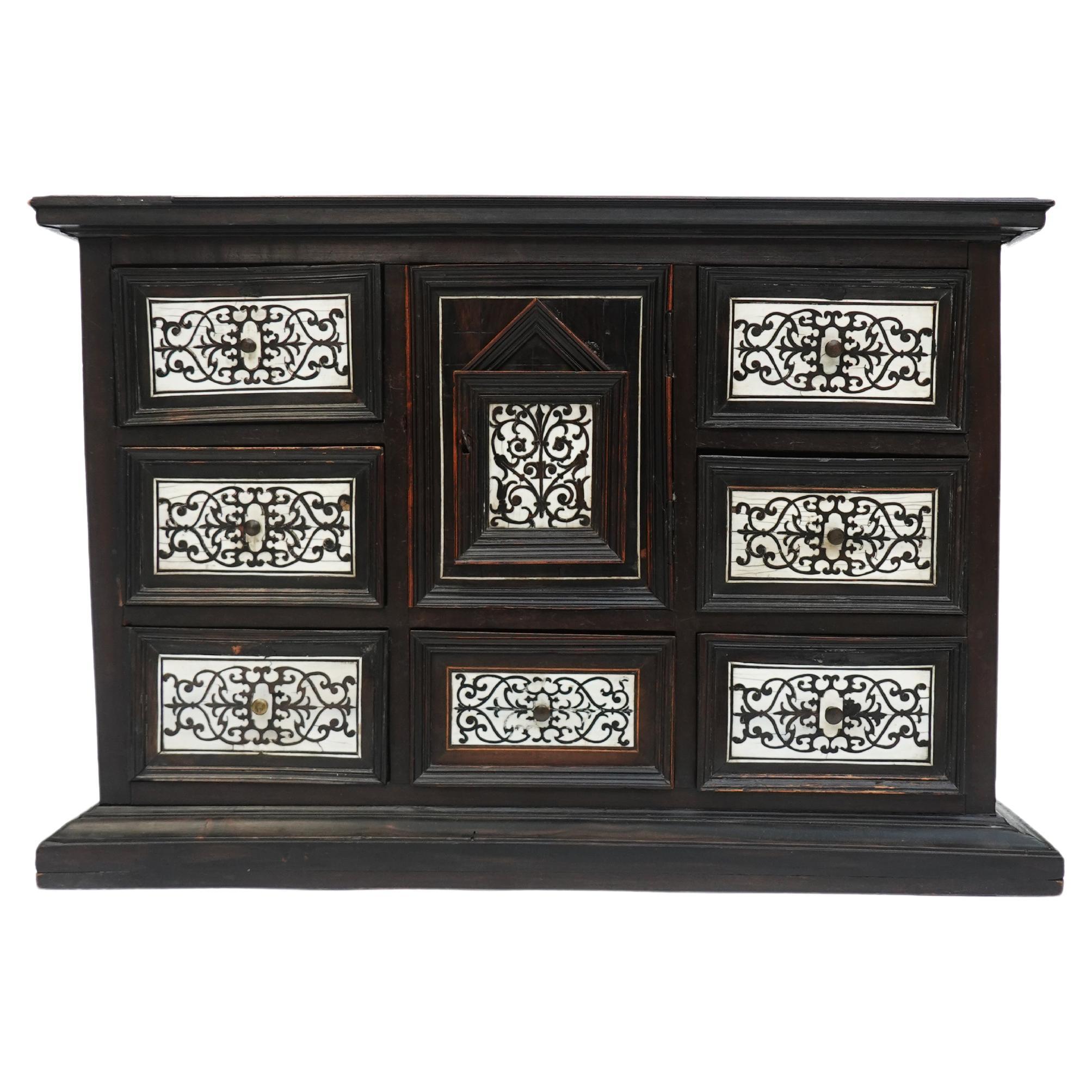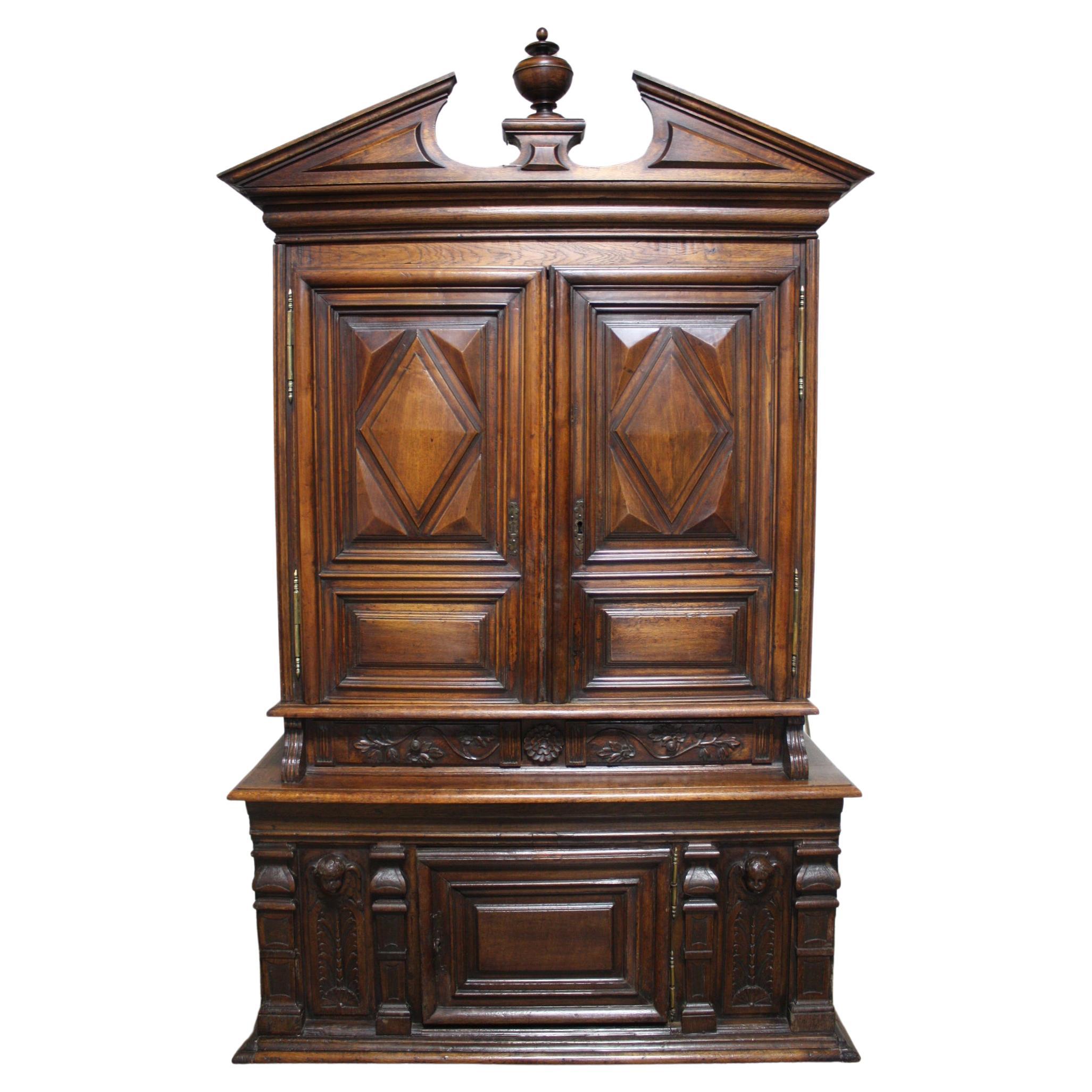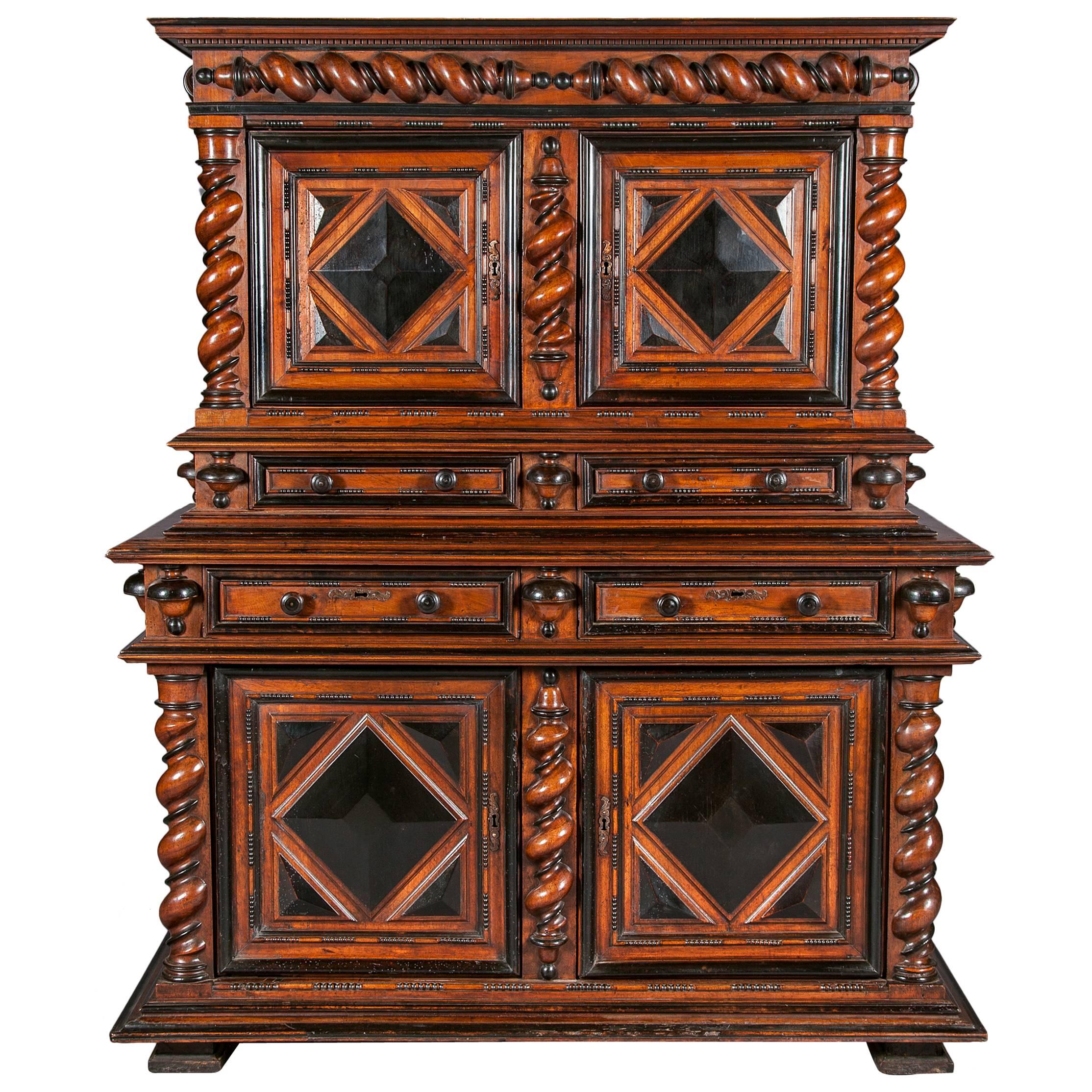Items Similar to Mughal Ivory Inlaid Wood Cabinet, 17th Century
Want more images or videos?
Request additional images or videos from the seller
1 of 5
Mughal Ivory Inlaid Wood Cabinet, 17th Century
About the Item
A Mughal ivory inlaid wood Cabinet
Noord-West Indie
17th century
27 x 40,2 x 30 cm
Cites number : 2023/BE00124/CE
Of rectangular form with fall-front opening profusely decorated in ivory inlay; sides with rectangular panels containing large inlaid ivory flowers within two border engraved with floral design; the front panel containing three large floral sprays surrounded by a double engraved border opening down to reveal eight drawers. This is a box that opens at the front to become a writing surface but also serving as a coffer in which to keep small precious objects such as jewelry or relics.
Produced in the north of India, in the region of the Great Mughal, this writing box adheres to a formal structure very close to that of European models.
While in India the colonial powers discovered, to their surprise, rare articles of courtly furniture richly worked and inlaid. However there was no local furniture that suited the settlers manner of living, so they commissioned extravagant pieces along European lines from native craftsmen, allowing them free rein with local materials.
Fall front cabinets such as this were designed to satisfy the demand of the settlers and many similar cabinets entered the collections of European aristocratic houses in the 17th and 18th centuries but they were also adopted by Indians, as seen in a Shah Jahan period miniature illustrated in Luxury Goods from India, the art of the cabinet maker, Amin Jaffer, 2002, p. 18.
This monumental fall-front cabinet was designed with an outstanding array of floral details. The popularity of flower studies in early seventeenth century Indian art followed on from a long-standing Mughal appreciation for flowers that since the days of Akbar had manifested itself in courtly painting and decorative arts but It was under Shah Jahan (r. 1628-58) however that the use of floral motifs were treated not as secondary decorative elements, but the primary focus of decoration. Jahangir's well-documented interest in flowers gave an added impetus to a group of artists and patrons already interested both in natural history and naturalism in painting. This is evident in the careful rendition of the floral stems on this example.
During Shah Jahan reign, similar floral motifs to those seen on our cabinet were found on a wide variety of media – such as the
The Saman Burj, Agra Fort (ca. 1637) decoration of buildings erected by the Emperor, for exemple the Saman Burj, Agra Fort (ca. 1637) or the Diwan-i ‘Amm in Ajmer as depicted in the Padshahnama (Milo Cleveland Beach and Ebba Koch, King of the World. The Padshahnama, exhibition catalogue, London, 1997, no.5, pp.28-29). By the second half of the 17th century similar motifs were popular also for cabinets (Basil Gray (ed.), The Arts of India, Oxford, 1981, p.180).
The resulting fusion of Western forms with Indian materials and decorative techniques gave rise to a wide range of luxury goods - cabinets, game-tables, painted boxes, ceremonial arms - that were breathtaking in their craftsmanship and widely prized in Europe.
With their intellectual curiosity and cultural policies, the Mughals were able to create a space of tolerance and harmonisation of different cultures.
This kind of cabinet illustrate the subtle interaction between European and Indian tastes and sensibilities, and chart the course of colonial patronage.
Bibliography:
Milo Cleveland Beach and Ebba Koch, King of the World. The Padshahnama, exhibition catalogue, London, 1997
Basil Gray (ed.), The Arts of India, Oxford, 1981
A. Jaffer, Luxury Goods from India: The Art of the Indian Cabinet-Maker, Victoria and Albert Museum, 2002
Brend in Arts of Mughal India : Studies in honour of Robert Skelton, ed. A. Topsfield, R. Crill, S. Stronge, London, 2004
- Dimensions:Height: 10.63 in (27 cm)Width: 15.83 in (40.2 cm)Depth: 11.82 in (30 cm)
- Style:Anglo-Indian (Of the Period)
- Materials and Techniques:
- Place of Origin:
- Period:
- Date of Manufacture:17th Century
- Condition:Repaired: Some inlaid ivory has been repaired. Wear consistent with age and use.
- Seller Location:Bruxelles, BE
- Reference Number:1stDibs: LU6666234253142
About the Seller
5.0
Vetted Seller
These experienced sellers undergo a comprehensive evaluation by our team of in-house experts.
1stDibs seller since 2022
6 sales on 1stDibs
Typical response time: 7 hours
- ShippingRetrieving quote...Ships From: Bruxelles, Belgium
- Return PolicyA return for this item may be initiated within 3 days of delivery.
More From This SellerView All
- Cerberus, Italy, 17th CenturyLocated in Bruxelles, BECerberus Black painted stone Italy, 17th century Measures: 80 x 69 x 36cm (one head missing) Cerberus, cruel monster, fierce and strange, Through his wide threefold throat barks as a dog Over the multitude immers'd beneath. His eyes glare crimson, black his unctuous beard, His belly large, and claw'd the hands, with which He tears the spirits, flays them, and their limbs Piecemeal disparts (Dante, Inferno, Canto VI). Cerberus figure seated, in his role of ferocious guardian of the underworld; he shows a nervous musculature, an adherent skin which reveals the ribs, long and robust limbs; his heads are broad and the eyes set well apart. Painted in black to amplify his menacing look, the infernal guardian is depicted with his famous attributes, writhing his heads, growling and barking furiously. Cerberus, in Greek mythology, was the monstrous watchdog of the underworld – also known as the “hound of Hades” – preventing the dead from leaving, and making sure that those who entered never left. A child of Typhon and Echidna, he was part of a monstrous family, which included Orthus, the Lernaean Hydra, and the Chimaera as well. Only on three occasions Cerberus was tricked by visitors of Hades: Heracles did it with his strength, Orpheus with his music. In "The Inferno", Dante places Cerberus as the guardian of the third circle of Hell. With his three mouths, Dante saw Cerberus as a beast that was synonymous with the sin of Gluttony. Virgil gets past the monster by throwing mud in his three mouths, temporarily choking him. Very rare are the representations of Cerberus in ancient statuary...Category
Antique 17th Century Italian Renaissance Figurative Sculptures
MaterialsStone
- Marble Lion, Périgord, 17th CenturyLocated in Bruxelles, BEMarble lion white marble France, probably Périgord, 17th century Small marble lion wearing a coat of arms pendant with the engraved date, ...Category
Antique 17th Century French Renaissance Animal Sculptures
MaterialsMarble
- Italian Memento Mori skull - 17th centuryLocated in Bruxelles, BEItalian Memento Mori skull Marble North of Italy, 17th century H 9 x L 7 x P 14 cm At the turn of the 16th century, they were the height of fashi...Category
Antique 17th Century Italian Renaissance Figurative Sculptures
MaterialsMarble
- A Captive Soldier - Italie (Rome), 17th centuryLocated in Bruxelles, BEA Captive Soldier Gilt Bronze, Lost Wax Italie (Rome), 17th century H 17 x Dia 10 cm H 6 2/3 x Dia 4 inch The 17th century witnessed a flourishing of artistic expression across Eur...Category
Antique 17th Century Italian Baroque Figurative Sculptures
MaterialsBronze
- Pair of Wooden Chairs, Lombardy, 17th CenturyLocated in Bruxelles, BEPair of beautifully carved wooden chairs Lombardy, first half of 17th century H 86 x L 48 x P 43 cm Pair of “da balia” (nanny) chairs. The backrest is decorated with winged myt...Category
Antique 17th Century Italian Renaissance Chairs
MaterialsWood
- Turned, Engraved Openwork Box, Florence, 17th CenturyLocated in Bruxelles, BETurned, engraved and openwork box Fruit wood Florence, 17th century Measures: Diameter 11cm Height 4.4cm.Category
Antique 17th Century Italian Renaissance Decorative Boxes
MaterialsWood
You May Also Like
- Table Counter Mughal Influence, 17th CenturyBy Europa AntiquesLocated in Madrid, ESTABLE COUNTER Mughal Influence, 17th century 17th century Lusíada, part of Mughal influence. In teak wood with inlaid ivories. With three drawers simulating four. Age defect...Category
Antique 17th Century Portuguese Renaissance Cabinets
MaterialsRosewood
- 17th Century Ebony Ivory Italian Travel CabinetLocated in PARIS, FRBeautiful 17th century travel cabinet made in marquetry of ivory and ebony. This piece was made in Italy, probably in north of the country, in Lomba...Category
Antique 17th Century Italian Louis XIII Cabinets
MaterialsIvory, Ebony, Wood
- French 17th Century CabinetLocated in Stockbridge, GAWhat a wonderful piece, full of character with the ornaments at the base and the putties carved in the wood.Category
Antique Late 17th Century French Renaissance Cabinets
MaterialsOak, Walnut
- Rare 17th Century Italian Louis XIV Inlaid Walnut Antique CabinetLocated in Casale Monferrato, ITImportant antique Italian Louis XIV period cabinet 1680s in walnut wood. Rafined Inlaid decoration on each side. On the front in the upper part six small drawers and a small central ...Category
Antique 1680s Italian Louis XIV Cabinets
MaterialsWalnut
- Flemish Coin Cabinet 17th CenturyBy Europa AntiquesLocated in Madrid, ESFlemish casket-bin, 17th century In walnut wood and ebonized. Nine drawers with painted mirror fronts. 38 x 73.5 x 30 cm. good condition.Category
Antique 17th Century Dutch Baroque Cabinets
MaterialsWood
- 17th Century, Dutch Oakwood CabinetLocated in Casteren, NLImpressive Dutch Renaissance "kussenkast", four-door cabinet. Solid oakwood with veneer. large corniche with carved heads decor. Raised panelled doors and sides with ripple mouldings...Category
Antique Late 17th Century Dutch Cabinets
MaterialsOak
Recently Viewed
View AllMore Ways To Browse
Grays Antique Jewellery London
Reiners Cabinet
Koch Flowers
India Ivory Inlaid Table
Antique Chart Table
Chinese Tallboy
Lane Bureau
Low Hutch
Satinwood Chiffonier
Spanish Book Shelves
Antique China Hutch Cabinet Mahogany
Antique Chinese Wedding Cupboard
Antique Corner Curio Display Cabinet
Antique Louis Xv Curio Cabinet
Be My Guest Cane Cabinet
Black Lacquer Hutch
Black Walnut Hutch
Broyhill China Hutch





